Arts Integration in Singapore's Preschool Education: A Report
VerifiedAdded on 2022/07/29
|5
|1232
|19
Report
AI Summary
This report examines the importance and relevance of integrating arts into preschool education within Singapore. The research aims to highlight the benefits of arts integration, focusing on its positive impacts on children's cognitive, intellectual, and creative skills. The study also considers how data from children's engagement with arts can inform teachers and curriculum developers. The report employs a qualitative document analysis, reviewing published documents to support the arguments. The study references various research papers that support the advantages of arts integration in early childhood education, including the promotion of long-term content retention and the development of cultural and interpersonal skills through performative arts. The report also discusses the roles of educators and the availability of resources like visual arts materials and props in facilitating arts integration. The findings emphasize the significance of arts education in Singapore's preschools and the need to address societal expectations that may hinder its integration. The research underscores the value of arts integration for the holistic development of children, providing valuable insights for educators and curriculum developers in Singapore.
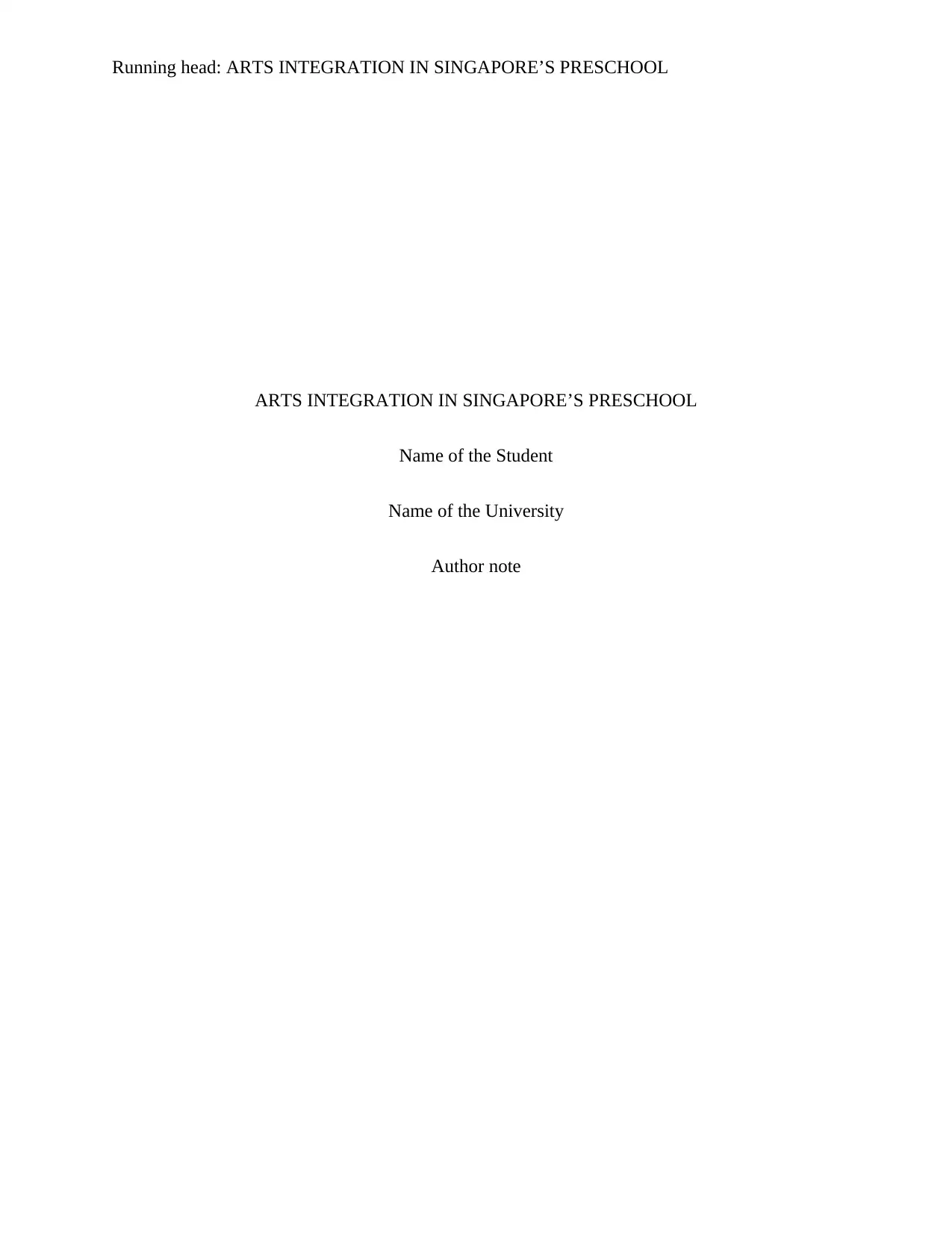
Running head: ARTS INTEGRATION IN SINGAPORE’S PRESCHOOL
ARTS INTEGRATION IN SINGAPORE’S PRESCHOOL
Name of the Student
Name of the University
Author note
ARTS INTEGRATION IN SINGAPORE’S PRESCHOOL
Name of the Student
Name of the University
Author note
Paraphrase This Document
Need a fresh take? Get an instant paraphrase of this document with our AI Paraphraser
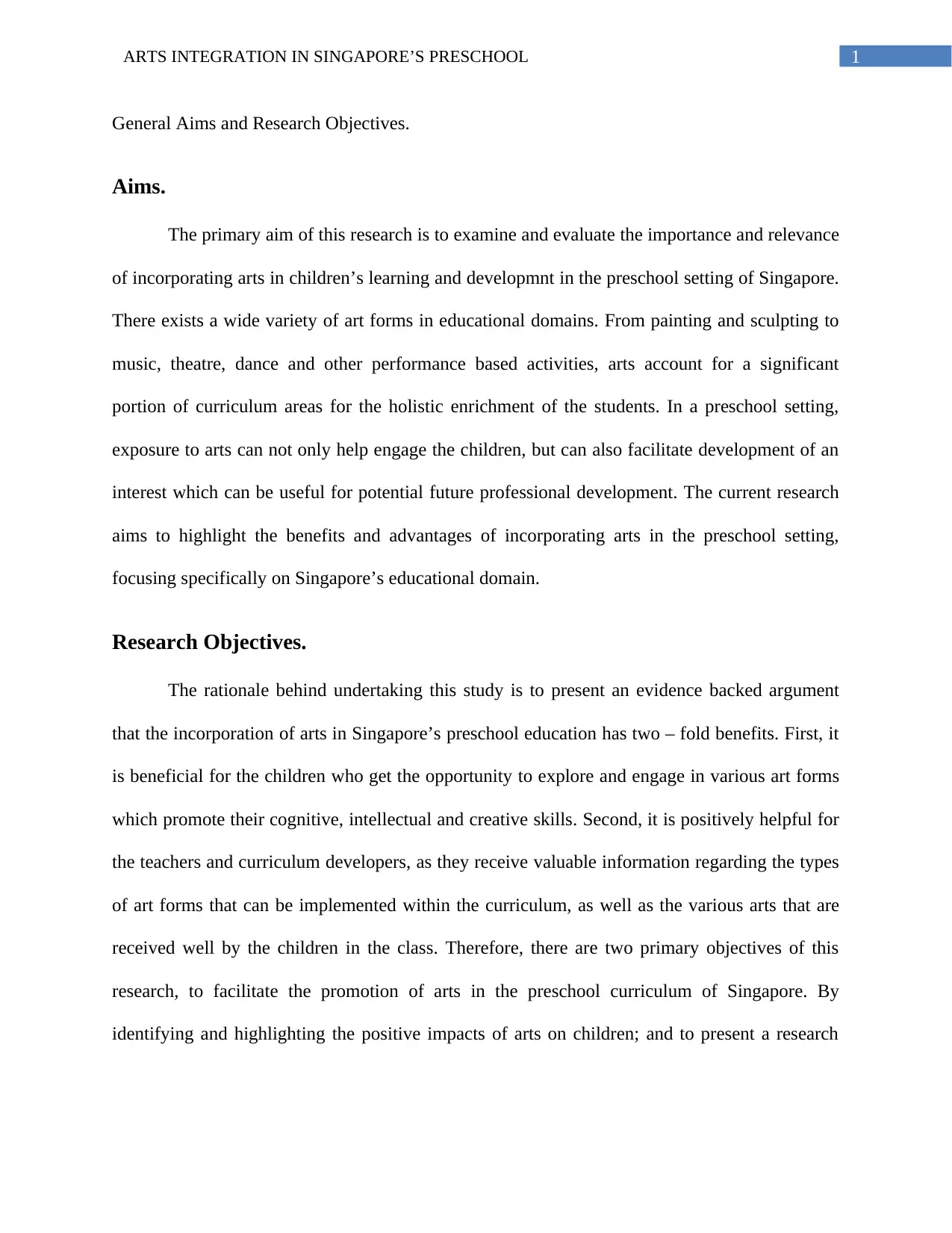
1ARTS INTEGRATION IN SINGAPORE’S PRESCHOOL
General Aims and Research Objectives.
Aims.
The primary aim of this research is to examine and evaluate the importance and relevance
of incorporating arts in children’s learning and developmnt in the preschool setting of Singapore.
There exists a wide variety of art forms in educational domains. From painting and sculpting to
music, theatre, dance and other performance based activities, arts account for a significant
portion of curriculum areas for the holistic enrichment of the students. In a preschool setting,
exposure to arts can not only help engage the children, but can also facilitate development of an
interest which can be useful for potential future professional development. The current research
aims to highlight the benefits and advantages of incorporating arts in the preschool setting,
focusing specifically on Singapore’s educational domain.
Research Objectives.
The rationale behind undertaking this study is to present an evidence backed argument
that the incorporation of arts in Singapore’s preschool education has two – fold benefits. First, it
is beneficial for the children who get the opportunity to explore and engage in various art forms
which promote their cognitive, intellectual and creative skills. Second, it is positively helpful for
the teachers and curriculum developers, as they receive valuable information regarding the types
of art forms that can be implemented within the curriculum, as well as the various arts that are
received well by the children in the class. Therefore, there are two primary objectives of this
research, to facilitate the promotion of arts in the preschool curriculum of Singapore. By
identifying and highlighting the positive impacts of arts on children; and to present a research
General Aims and Research Objectives.
Aims.
The primary aim of this research is to examine and evaluate the importance and relevance
of incorporating arts in children’s learning and developmnt in the preschool setting of Singapore.
There exists a wide variety of art forms in educational domains. From painting and sculpting to
music, theatre, dance and other performance based activities, arts account for a significant
portion of curriculum areas for the holistic enrichment of the students. In a preschool setting,
exposure to arts can not only help engage the children, but can also facilitate development of an
interest which can be useful for potential future professional development. The current research
aims to highlight the benefits and advantages of incorporating arts in the preschool setting,
focusing specifically on Singapore’s educational domain.
Research Objectives.
The rationale behind undertaking this study is to present an evidence backed argument
that the incorporation of arts in Singapore’s preschool education has two – fold benefits. First, it
is beneficial for the children who get the opportunity to explore and engage in various art forms
which promote their cognitive, intellectual and creative skills. Second, it is positively helpful for
the teachers and curriculum developers, as they receive valuable information regarding the types
of art forms that can be implemented within the curriculum, as well as the various arts that are
received well by the children in the class. Therefore, there are two primary objectives of this
research, to facilitate the promotion of arts in the preschool curriculum of Singapore. By
identifying and highlighting the positive impacts of arts on children; and to present a research
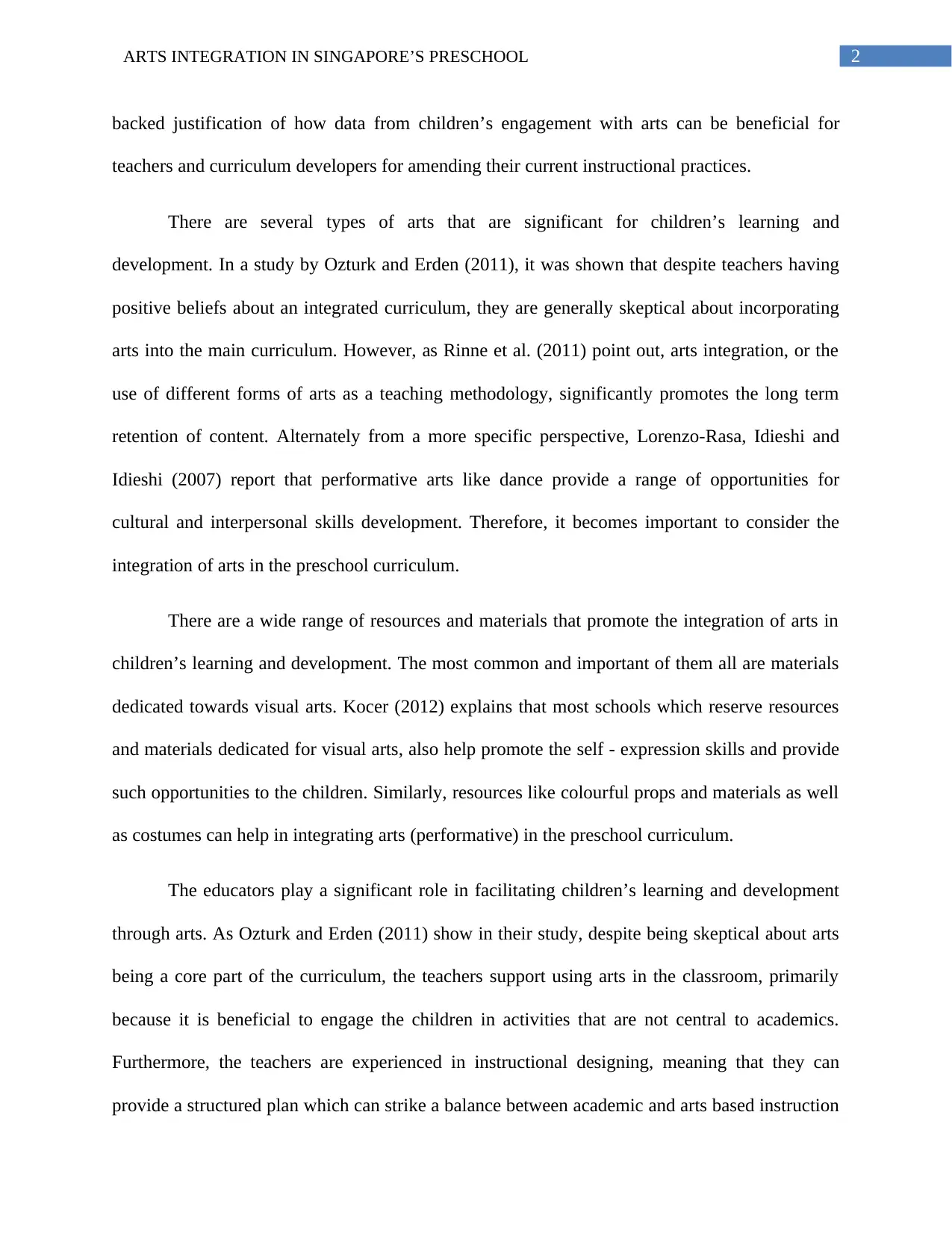
2ARTS INTEGRATION IN SINGAPORE’S PRESCHOOL
backed justification of how data from children’s engagement with arts can be beneficial for
teachers and curriculum developers for amending their current instructional practices.
There are several types of arts that are significant for children’s learning and
development. In a study by Ozturk and Erden (2011), it was shown that despite teachers having
positive beliefs about an integrated curriculum, they are generally skeptical about incorporating
arts into the main curriculum. However, as Rinne et al. (2011) point out, arts integration, or the
use of different forms of arts as a teaching methodology, significantly promotes the long term
retention of content. Alternately from a more specific perspective, Lorenzo-Rasa, Idieshi and
Idieshi (2007) report that performative arts like dance provide a range of opportunities for
cultural and interpersonal skills development. Therefore, it becomes important to consider the
integration of arts in the preschool curriculum.
There are a wide range of resources and materials that promote the integration of arts in
children’s learning and development. The most common and important of them all are materials
dedicated towards visual arts. Kocer (2012) explains that most schools which reserve resources
and materials dedicated for visual arts, also help promote the self - expression skills and provide
such opportunities to the children. Similarly, resources like colourful props and materials as well
as costumes can help in integrating arts (performative) in the preschool curriculum.
The educators play a significant role in facilitating children’s learning and development
through arts. As Ozturk and Erden (2011) show in their study, despite being skeptical about arts
being a core part of the curriculum, the teachers support using arts in the classroom, primarily
because it is beneficial to engage the children in activities that are not central to academics.
Furthermore, the teachers are experienced in instructional designing, meaning that they can
provide a structured plan which can strike a balance between academic and arts based instruction
backed justification of how data from children’s engagement with arts can be beneficial for
teachers and curriculum developers for amending their current instructional practices.
There are several types of arts that are significant for children’s learning and
development. In a study by Ozturk and Erden (2011), it was shown that despite teachers having
positive beliefs about an integrated curriculum, they are generally skeptical about incorporating
arts into the main curriculum. However, as Rinne et al. (2011) point out, arts integration, or the
use of different forms of arts as a teaching methodology, significantly promotes the long term
retention of content. Alternately from a more specific perspective, Lorenzo-Rasa, Idieshi and
Idieshi (2007) report that performative arts like dance provide a range of opportunities for
cultural and interpersonal skills development. Therefore, it becomes important to consider the
integration of arts in the preschool curriculum.
There are a wide range of resources and materials that promote the integration of arts in
children’s learning and development. The most common and important of them all are materials
dedicated towards visual arts. Kocer (2012) explains that most schools which reserve resources
and materials dedicated for visual arts, also help promote the self - expression skills and provide
such opportunities to the children. Similarly, resources like colourful props and materials as well
as costumes can help in integrating arts (performative) in the preschool curriculum.
The educators play a significant role in facilitating children’s learning and development
through arts. As Ozturk and Erden (2011) show in their study, despite being skeptical about arts
being a core part of the curriculum, the teachers support using arts in the classroom, primarily
because it is beneficial to engage the children in activities that are not central to academics.
Furthermore, the teachers are experienced in instructional designing, meaning that they can
provide a structured plan which can strike a balance between academic and arts based instruction
⊘ This is a preview!⊘
Do you want full access?
Subscribe today to unlock all pages.

Trusted by 1+ million students worldwide
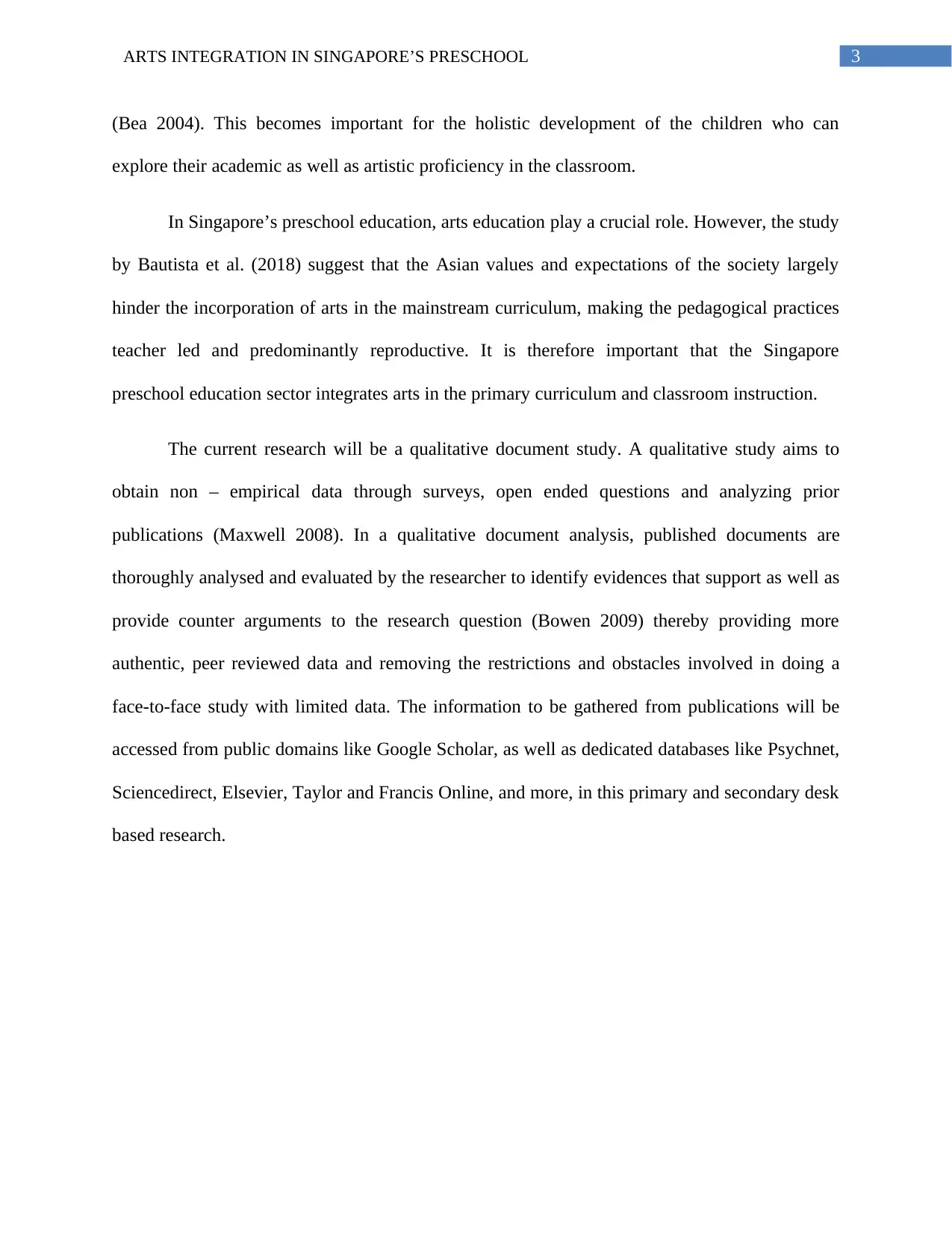
3ARTS INTEGRATION IN SINGAPORE’S PRESCHOOL
(Bea 2004). This becomes important for the holistic development of the children who can
explore their academic as well as artistic proficiency in the classroom.
In Singapore’s preschool education, arts education play a crucial role. However, the study
by Bautista et al. (2018) suggest that the Asian values and expectations of the society largely
hinder the incorporation of arts in the mainstream curriculum, making the pedagogical practices
teacher led and predominantly reproductive. It is therefore important that the Singapore
preschool education sector integrates arts in the primary curriculum and classroom instruction.
The current research will be a qualitative document study. A qualitative study aims to
obtain non – empirical data through surveys, open ended questions and analyzing prior
publications (Maxwell 2008). In a qualitative document analysis, published documents are
thoroughly analysed and evaluated by the researcher to identify evidences that support as well as
provide counter arguments to the research question (Bowen 2009) thereby providing more
authentic, peer reviewed data and removing the restrictions and obstacles involved in doing a
face-to-face study with limited data. The information to be gathered from publications will be
accessed from public domains like Google Scholar, as well as dedicated databases like Psychnet,
Sciencedirect, Elsevier, Taylor and Francis Online, and more, in this primary and secondary desk
based research.
(Bea 2004). This becomes important for the holistic development of the children who can
explore their academic as well as artistic proficiency in the classroom.
In Singapore’s preschool education, arts education play a crucial role. However, the study
by Bautista et al. (2018) suggest that the Asian values and expectations of the society largely
hinder the incorporation of arts in the mainstream curriculum, making the pedagogical practices
teacher led and predominantly reproductive. It is therefore important that the Singapore
preschool education sector integrates arts in the primary curriculum and classroom instruction.
The current research will be a qualitative document study. A qualitative study aims to
obtain non – empirical data through surveys, open ended questions and analyzing prior
publications (Maxwell 2008). In a qualitative document analysis, published documents are
thoroughly analysed and evaluated by the researcher to identify evidences that support as well as
provide counter arguments to the research question (Bowen 2009) thereby providing more
authentic, peer reviewed data and removing the restrictions and obstacles involved in doing a
face-to-face study with limited data. The information to be gathered from publications will be
accessed from public domains like Google Scholar, as well as dedicated databases like Psychnet,
Sciencedirect, Elsevier, Taylor and Francis Online, and more, in this primary and secondary desk
based research.
Paraphrase This Document
Need a fresh take? Get an instant paraphrase of this document with our AI Paraphraser
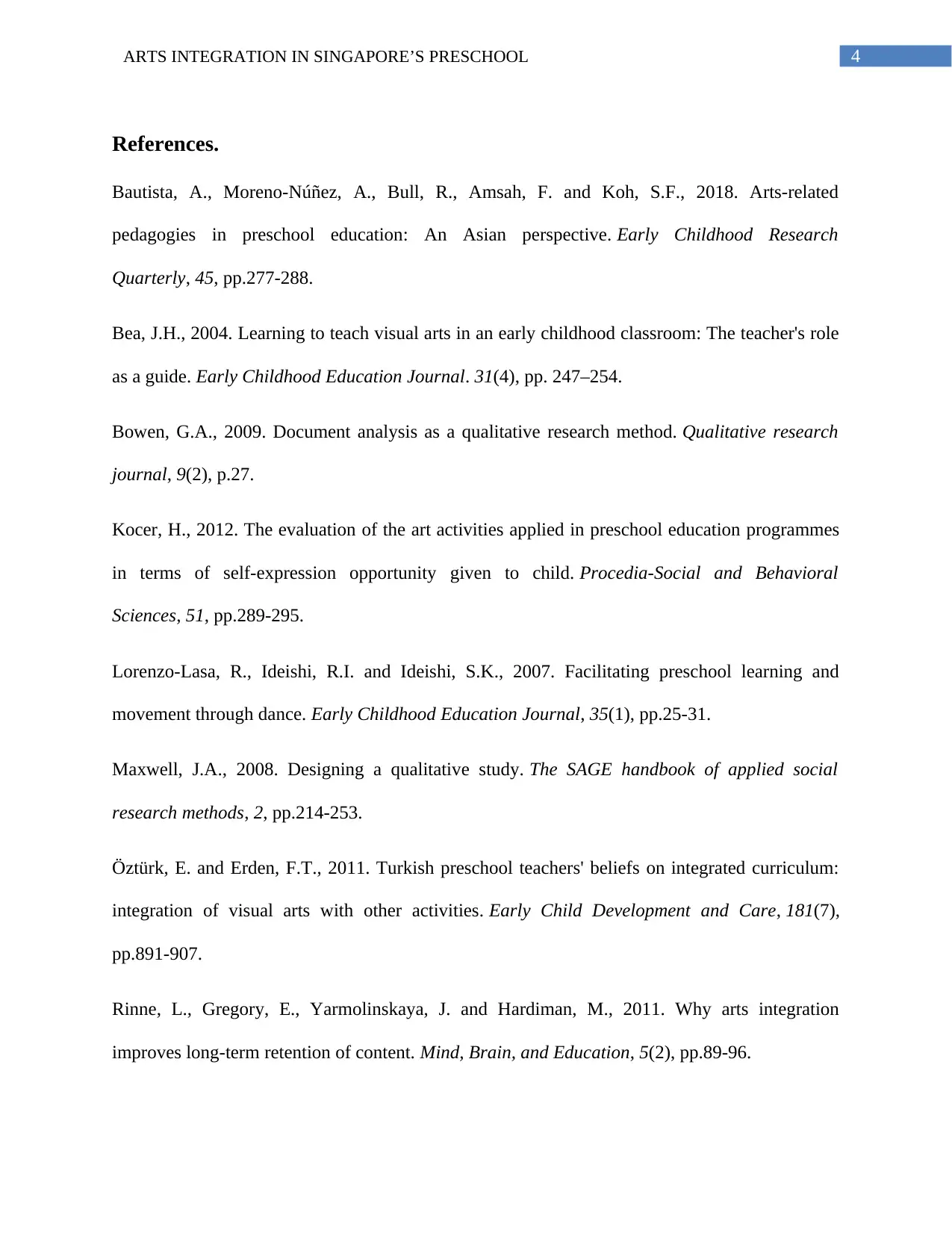
4ARTS INTEGRATION IN SINGAPORE’S PRESCHOOL
References.
Bautista, A., Moreno-Núñez, A., Bull, R., Amsah, F. and Koh, S.F., 2018. Arts-related
pedagogies in preschool education: An Asian perspective. Early Childhood Research
Quarterly, 45, pp.277-288.
Bea, J.H., 2004. Learning to teach visual arts in an early childhood classroom: The teacher's role
as a guide. Early Childhood Education Journal. 31(4), pp. 247–254.
Bowen, G.A., 2009. Document analysis as a qualitative research method. Qualitative research
journal, 9(2), p.27.
Kocer, H., 2012. The evaluation of the art activities applied in preschool education programmes
in terms of self-expression opportunity given to child. Procedia-Social and Behavioral
Sciences, 51, pp.289-295.
Lorenzo-Lasa, R., Ideishi, R.I. and Ideishi, S.K., 2007. Facilitating preschool learning and
movement through dance. Early Childhood Education Journal, 35(1), pp.25-31.
Maxwell, J.A., 2008. Designing a qualitative study. The SAGE handbook of applied social
research methods, 2, pp.214-253.
Öztürk, E. and Erden, F.T., 2011. Turkish preschool teachers' beliefs on integrated curriculum:
integration of visual arts with other activities. Early Child Development and Care, 181(7),
pp.891-907.
Rinne, L., Gregory, E., Yarmolinskaya, J. and Hardiman, M., 2011. Why arts integration
improves long‐term retention of content. Mind, Brain, and Education, 5(2), pp.89-96.
References.
Bautista, A., Moreno-Núñez, A., Bull, R., Amsah, F. and Koh, S.F., 2018. Arts-related
pedagogies in preschool education: An Asian perspective. Early Childhood Research
Quarterly, 45, pp.277-288.
Bea, J.H., 2004. Learning to teach visual arts in an early childhood classroom: The teacher's role
as a guide. Early Childhood Education Journal. 31(4), pp. 247–254.
Bowen, G.A., 2009. Document analysis as a qualitative research method. Qualitative research
journal, 9(2), p.27.
Kocer, H., 2012. The evaluation of the art activities applied in preschool education programmes
in terms of self-expression opportunity given to child. Procedia-Social and Behavioral
Sciences, 51, pp.289-295.
Lorenzo-Lasa, R., Ideishi, R.I. and Ideishi, S.K., 2007. Facilitating preschool learning and
movement through dance. Early Childhood Education Journal, 35(1), pp.25-31.
Maxwell, J.A., 2008. Designing a qualitative study. The SAGE handbook of applied social
research methods, 2, pp.214-253.
Öztürk, E. and Erden, F.T., 2011. Turkish preschool teachers' beliefs on integrated curriculum:
integration of visual arts with other activities. Early Child Development and Care, 181(7),
pp.891-907.
Rinne, L., Gregory, E., Yarmolinskaya, J. and Hardiman, M., 2011. Why arts integration
improves long‐term retention of content. Mind, Brain, and Education, 5(2), pp.89-96.
1 out of 5
Related Documents
Your All-in-One AI-Powered Toolkit for Academic Success.
+13062052269
info@desklib.com
Available 24*7 on WhatsApp / Email
![[object Object]](/_next/static/media/star-bottom.7253800d.svg)
Unlock your academic potential
Copyright © 2020–2025 A2Z Services. All Rights Reserved. Developed and managed by ZUCOL.





